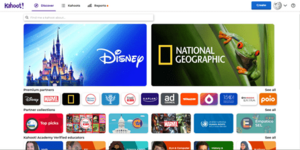Kahoot! facts for kids
 |
|
| Available in | English, Dutch, French, German, Indonesian, Italian, Japanese, Malay, Norwegian, Polish, Portuguese, Spanish, Swedish, Turkish, Ukrainian, Arabic, Chinese |
|---|---|
| Country of origin | Norway |
| Owner | Kahoot! ASA |
| Website | Main website: Game: |
| Commercial | Yes |
| Registration | None for quiz participation; required for quiz creation |
| Users | 7 billion non-unique players as of 2022 |
| Launched | September 2013 |
Kahoot! is a fun online platform from Norway that helps people learn through games. It offers learning games called "kahoots." These are quizzes, usually with multiple-choice questions, that people create themselves. You can play kahoots using a web browser or the Kahoot! app on your phone or tablet.
Contents
History of Kahoot!
How Kahoot! Started
The idea for Kahoot! came from a project called "Lecture Quiz." This project was developed by Alf Inge Wang at the Norwegian University of Science and Technology (NTNU) in 2006. The first version, Lecture Quiz 1.0, allowed teachers to create quizzes. Students could answer using their mobile phones or laptops.
Later versions of Lecture Quiz made it easier to use. Lecture Quiz 2.0, developed in 2011, was the first to let both teachers and students use it through a web browser. The final version, Lecture Quiz 3.0 in 2012, had a better look and feel. It also added fun features like avatars and different game modes.
The Company's Journey
Kahoot! became a company in 2012. It was founded by Morten Versvik, who was one of Wang's students. Johan Brand, Jamie Brooker, and Asmund Furuseth joined later. They helped design the platform and make it easy to use. A test version of Kahoot! was launched in September 2013.
By March 2017, over one billion people had played Kahoot! games. In September 2017, Kahoot! released a mobile app. This app allowed students to play kahoots for homework.
Kahoot! grew by buying other companies. In 2019, they acquired Poio, a Scandinavian education company. They also bought DragonBox, which makes educational games.
In 2020, Kahoot! became a very valuable company, worth $1.5 billion. By 2021, its value had grown to $7 billion. They continued to acquire more companies. In 2020, they bought Drops, an app for learning languages. They also acquired Whiteboard.fi, which creates digital whiteboards. Kahoot! also purchased Actimo, a company that makes software for training employees. This helped Kahoot! offer more features for businesses.
In March 2021, the company's shares started trading on the Oslo stock exchange. In April 2021, Kahoot! acquired Motimate, another learning company from Norway. Later in 2021, Kahoot! announced plans to acquire Clever, Inc. This company provides a digital learning platform. In 2023, a group of investors, including Goldman Sachs Asset Management, acquired Kahoot! for $1.72 billion.
Research on Learning with Kahoot!
Experts have studied how Kahoot! helps with learning. In 2016, Education Alliance Finland looked at Kahoot!'s teaching quality. They found that Kahoot! is most helpful when students create their own quizzes. This helps them be creative and practice important skills for the 21st century.
A large review of 93 studies was published in 2020. It showed that using Kahoot! in classrooms had many good effects. It made classes more lively and helped students learn better. It also helped reduce anxiety about learning.
See also
 In Spanish: Kahoot! para niños
In Spanish: Kahoot! para niños
- Quizlet
- Anki
- Chegg
- Course Hero


